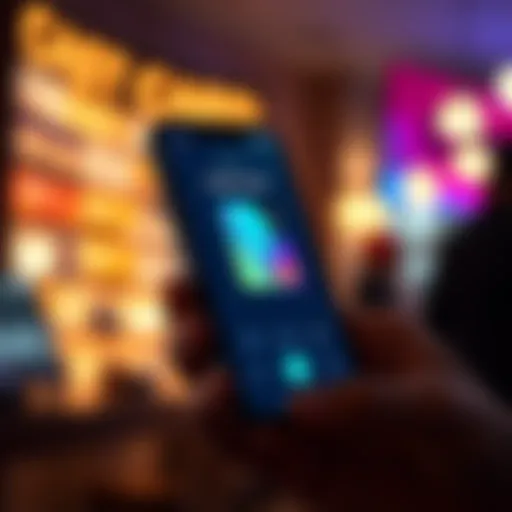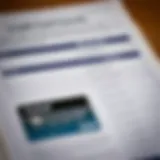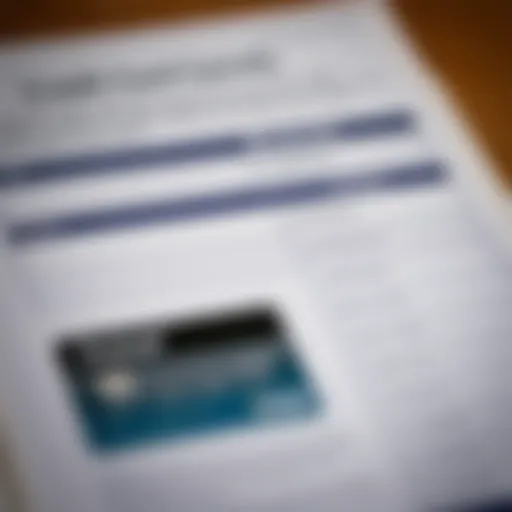Linking Your Bank Account to a Blockchain Exchange


Intro
In the realm of digital finance, an increasing number of individuals are exploring the world of blockchain exchanges. The fusion of traditional banking with modern blockchain technology creates a new arena for investment opportunities but can also feel like walking through a maze. For both seasoned pros and newbies alike, understanding how to link a bank account to a blockchain exchange is a crucial skill. This integration not only streamlines the trading experience but also opens the door for robust investment strategies.
To truly grasp this process, one must familiarize themselves with some foundational concepts and terminology. That’s where our comprehensive exploration begins.
Key Concepts and Definitions
When diving into the expansive universe of blockchain exchanges, it is essential to first break down some key terms.
Overview of Investment Terms
- Blockchain: A decentralized digital ledger that records transactions across many computers. Each transaction is grouped into blocks, which are then linked together to form a chain.
- Exchange: A platform where users can trade cryptocurrencies or digital assets. Some allow direct trading with fiat currencies, others primarily focus on cryptocurrency-to-cryptocurrency exchanges.
- Fiat Currency: Traditional currency that is backed by a government, like the US dollar or euro, as opposed to cryptocurrencies which derive their value from technology and market demand.
Understanding these terms ensures that users know what they’re dealing with at every stage of the process. It might sound basic, but not grasping these concepts can lead to confusion and missteps.
Significance of Understanding Financial Terminology
Grasping financial terminology is not just a matter of academic interest; it’s about gearing up for practical engagement in the market. Knowing what terms like "liquidity," "volatility," and "market cap" mean can significantly impact decision-making.
"In finance, not understanding risks and rewards can cost you dearly; clarity can be your best ally."
Indeed, being well-versed in the basics can bolster confidence when making investment choices or entering discussions with other traders.
Expert Insights and Advice
Learning the ropes doesn't stop at definitions. Real-world application of these terms is where the rubber meets the road. Here, we offer insights tailored to different levels of investors.
Investment Strategies for Beginners
For those just starting out, the approach can seem daunting. Here are some strategies to ease your way into the investments:
- Start small: Never invest more than you can afford to lose. It’s about learning as much as earning.
- Diversify: Don’t put all your eggs in one basket. Spreading investments across various assets can mitigate risks.
- Educate yourself: Regularly dive into blogs, podcasts, and forums. Sites like reddit.com can be a goldmine for discussions and tips among investors.
Advanced Techniques for Seasoned Investors
For those who’ve been around the block, it’s important to keep evolving:
- Arbitrage Opportunities: Look for price discrepancies across different exchanges. This can offer quick profits if done right, but speed is essential.
- Technical Analysis: Utilize charts and indicators to predict future market movements based on historical data. Mastering this can provide a significant edge.
- Risk Management: Know when to hold 'em and when to fold 'em. Plan your exits in advance to minimize losses.
Linking your bank account to a blockchain exchange is just the beginning of a thorough investment journey. As we cascade through the subsequent sections of this guide, the real processes, security features, and implications of this integration will unfold, step by step.
Understanding Blockchain Exchanges
Blockchain exchanges are at the heart of the cryptocurrency world, providing the vital infrastructure for trading digital assets. Grasping the concept of these exchanges is paramount for both novice and seasoned investors. Understanding their mechanisms helps one maneuver through the often murky waters of digital finance.
Primarily, a blockchain exchange is a platform that allows people to buy, sell, or trade cryptocurrencies for other digital currency or traditional currency such as US dollars or Euro. This function enhances liquidity and accessibility, making it easier for anyone to dive into crypto trading. As the backbone of the cryptocurrency market, exchanges contribute significantly to price discovery and provide investors with crucial market data.
What is a Blockchain Exchange?
At its core, a blockchain exchange is a marketplace where cryptocurrencies are traded. These exchanges operate similarly to stock exchanges, where buyers and sellers come together to negotiate prices.
A unique aspect of blockchain exchanges is that they function on blockchain technology. Each transaction is tracked and recorded on a public ledger, promoting transparency. Every time someone buys or sells, the exchange must verify the transaction and match it against the decentralized ledger. Because of that, trust becomes a vital part of all trading interactions. Without trust in the exchange platform, no one would dare to buy or sell.
Types of Blockchain Exchanges
Understanding the various types of exchanges can help investors select the right platform for their needs.
Centralized Exchanges
Centralized exchanges, such as Coinbase and Binance, are the most common types in the market. They serve as intermediaries between buyers and sellers. A major key characteristic is that they require users to create accounts and store funds directly on the exchange. This makes them user-friendly and appealing to newcomers who might feel hesitant to manage their private keys from the get-go.
One significant advantage of centralized exchanges is their liquidity; they often have massive transaction volumes, resulting in quick trades. However, the reliance on a central authority can also be a double-edged sword. Users may face risks, such as hacking or company shutdowns, leading to potential loss of funds. Thus, it's essential for users to perform due diligence regarding the exchange's security features.
Decentralized Exchanges
Decentralized exchanges (DEXs) offer a markedly different approach. Here, trades occur directly between users via automated processes known as smart contracts, eliminating the need for a third-party. Uniswap and PancakeSwap are popular examples that have attracted much attention in the trading community.


The primary appeal of DEXs lies in their emphasis on privacy and user control. Users retain ownership of their funds, and personal information is often kept anonymous. However, this model requires users to have a deeper understanding of wallets and blockchain operations. As a downside, liquidity may not be as substantial as it is on centralized platforms, which can lead to longer processing times for trades.
Hybrid Exchanges
Hybrid exchanges aim to combine the strengths of both centralized and decentralized exchanges. They provide a platform where users can engage in peer-to-peer trading while still offering the liquidity and advanced features typically found in centralized systems. An example of this is Nash Exchange.
The main characteristic that makes hybrid exchanges attractive is their flexibility. They cater to both seasoned traders who value privacy and control, as well as beginners who prefer the user-centric features of a centralized exchange. However, these platforms can encounter challenges related to implementing efficient security measures while maintaining usability.
Benefits of Using Blockchain Exchanges
Using blockchain exchanges comes with a multitude of benefits:
- Accessibility: Anyone with internet access can trade cryptocurrencies.
- Variety of Assets: Exchanges often support a wide range of cryptocurrencies, giving users diverse investment opportunities.
- Market Data: Exchanges provide real-time data on trends, helping investors make informed decisions.
In summary, understanding blockchain exchanges forms the basis for grasping the next steps in linking bank accounts and exploring digital assets. It simply can't be understated how crucial this foundational knowledge is in navigating the ever-evolving landscape of cryptocurrency.
Preliminary Considerations Before Linking Your Bank Account
Before you tie the knot with any blockchain exchange, it’s crucial to take a moment to ponder the path ahead. Linking your bank account isn't just a casual affair; it’s a commitment that melds traditional finance with the often-unpredictable world of digital assets. With every crypto transaction weaving a few twists and turns, understanding the implications can make a significant difference in your investment journey.
Assessing Your Investment Goals
When stepping into the digital asset game, knowing what you want from it is half the battle. Are you in it for the long haul, aiming for retirement savings, or are you more of a thrill-seeker drawn to short-term gains? Your investment goals set the tone for everything that follows.
- Long-term Strategy: If you’re eyeing retirement funds, performance and stability should be your top priority.
- Short-term Trading: On the flip side, if you thrive on the adrenaline rush, daily fluctuations might be your playground.
So, carve out some time to clarify your vision. After all, a clear destination often points to a smoother ride.
Understanding Fees and Costs
Fees on blockchain exchanges can feel like hidden gremlins; they pop up when you least expect them. Understanding the fees associated with linking your bank account helps to illuminate your financial landscape.
- Transaction Fees: Most exchanges charge a fee for buying and selling crypto. Be wary of the percentages; they can eat away at your profits.
- Withdrawal Fees: While you might think you're safe, withdrawing funds often brings its own cost.
Reading the fine print is not just for the cautious. It’s a necessary step for anyone wanting to preserve their hard-earned money.
Evaluating Security Features
Security should never be the last item on your checklist; it should be front and center like a neon sign. In the world of blockchain exchanges, safeguarding your financial data is paramount. Here’s what to focus on:
Two-Factor Authentication
Two-Factor Authentication (2FA) adds an extra layer of protection like a bouncer at an exclusive nightclub. This security measure asks you to verify your identity through multiple forms. Typically, you might enter a password, then confirm a code sent to your mobile device.
- Key Characteristic: The essence of 2FA is that it needs not just your password but also something you have, making impersonation more difficult.
- Advantages: Given its simplicity and effectiveness, 2FA is popular among exchanges aiming for customer trust.
While no system is foolproof, using 2FA certainly makes it more challenging for ill-intentioned entities to access your account.
Cold Storage Options
Cold Storage refers to keeping cryptocurrencies offline. Imagine locking your valuables in a safe rather than leaving them out on your kitchen table; that’s cold storage for you.
- Key Characteristic: Unlike your regular exchange wallets, cold storage is immune to online hacks.
- Benefits: It’s well-suited for individuals who plan on holding their cryptocurrencies longer and aren’t looking to trade frequently.
The peace of mind that comes with knowing your valuable assets are offline often outweighs the inconvenience of accessing them.
In the realm of finance and investments, patience, combined with securing your assets, often pays off in the long run.
The Technical Process of Linking a Bank Account
Understanding the technical process of linking a bank account to a blockchain exchange is vital for anyone looking to invest in digital assets. It’s not just about moving money around; it’s about ensuring security, efficiency, and compliance with regulations. With this knowledge, investors can make informed choices, taking full advantage of what blockchain technology offers.
Choosing the Right Blockchain Exchange
When it comes to linking your bank account, the first step is to choose an appropriate blockchain exchange. Factors like the exchange's reputation, user interface, supported currencies, and overall trading volume are crucial. For instance, a well-established exchange like Coinbase or Binance often means more reliable transactions and better security measures. However, the choice also hinges on your personal trading goals and preferences. Keep in mind, some exchanges may cater to specific regions or have unique offerings.
Completing Registration on the Exchange
Once you've picked a blockchain exchange, the next step is to complete your registration. This might feel like a small hurdle, but the registration process establishes a fundamental trust between you and the exchange. You’ll typically need to provide personal details such as your name, email, and in many cases, identity verification documents. It’s essential to fill out this form accurately to avoid future problems. Bear in mind that some exchanges might have strict criteria for user verification due to legal requirements.


Navigating to Payment Settings
After registering, make your way to the payment settings section of the platform. Finding this area might seem easy, but interface designs can vary widely among exchanges. Look for terms like 'Payment Methods' or 'Accounts'. Here, you will have an overview of how you can set up your financial accounts. Navigating this section carefully is crucial, as any incorrect input could lead to transaction issues later on.
Entering Bank Account Information
Inputting your bank account information is a critical step. You’ll need to provide details like your bank account number and routing number. It’s vital to ensure that everything is accurate down to the last digit. Missing just one number could prevent you from linking your account properly. Take your time and double-check that you've entered this information correctly. Poor data entry at this stage could create mazes of financial trouble down the road.
Verifying Your Bank Account
Verification comes next, and this is design to ensure that you're the rightful owner of the linked bank account. Different exchanges may use distinctive methods for this step.
Micro-deposit Verification
The micro-deposit verification method involves the exchange sending small amounts—often just a few cents—to your bank account. This process serves two purposes: it confirms that the bank account is active, and it provides you with a unique identifier that you must then input back into the exchange. This method is quite popular due to its simplicity. A key characteristic here is its low risk, making it a favored choice for many. The notable advantage is also that it doesn’t require extensive personal information beyond what's already provided. However, one downside is the wait time; it could take a few days for those small deposits to reflect in your account.
Instant Verification Methods
On the other side, we have instant verification methods. This process often involves using a third-party service that connects directly to your bank through secure methods, allowing for fast verification. An attractive feature here is the speed. You can often link your account within moments rather than days. It’s a beneficial solution for active traders looking to jump in quickly. Nonetheless, this method may require you to share more personal information with the verification service, raising privacy concerns for some users. Keep in mind that not all financial institutions support this path, which might affect your options.
In summary, understanding the technical process of linking your bank account to a blockchain exchange encompasses several important steps. Each phase is crucial for a streamlined investment journey. Adhering to this guide can pave the way for a smooth linking experience and greater success in managing your digital assets.
Understanding the Role of Blockchain Technology
Linking a bank account to a blockchain exchange is not just about making transactions easier. It's about understanding the foundational technology — blockchain — that powers these exchanges. Knowledge of blockchain is critical for anyone who wants to dive into this evolving financial landscape. This section breaks down essential elements and implications of blockchain technology that every investor should grasp.
How Transactions are Processed on the Blockchain
The transaction processing on a blockchain occurs in a decentralized manner, ensuring that no single entity has control over the data. Each transaction is grouped together into blocks and linked to one another in a chronological chain. This is where the transparency comes in — all participants in the network can see the transactions, ensuring accountability and reducing fraud.
- Verification: Before a transaction is recorded, it must be verified by network nodes using complex algorithms. This process is essential to prevent double-spending and ensures that funds are legitimate.
- Consensus Mechanisms: Various consensus mechanisms like proof-of-work or proof-of-stake govern how nodes reach an agreement on the validity of transactions. Each mechanism has its pros and cons, impacting everything from speed to energy efficiency.
- Data Integrity: Once transactions are confirmed, they become immutable. This ensures that no one can tamper with past transactions, providing a secure ledger of all activity.
The beauty of blockchain technology lies in its ability to enhance trust without the need for intermediaries. With the growing number of exchanges leveraging this technology, understanding its workings can help users make more informed choices in their investment decisions.
Smart Contracts and Their Implications
Smart contracts are self-executing contracts with the terms directly written into code. When certain pre-defined conditions are met, the contract self-executes, automating processes that would normally require manual oversight. This has profound implications for financial transactions linked to blockchain exchanges.
- Efficiency: Automating processes reduces time delays and lowers operational costs, making transactions quicker and cheaper.
- Transparency: Since smart contracts are stored on the blockchain, they can remain transparent, allowing anyone with access to the blockchain to view contract terms and status.
- Error Reduction: Human errors are significantly diminished, as the entire interaction is coded; this ensures that contract execution follows the specified conditions with precision.
However, it’s vital to remember that while smart contracts offer remarkable advantages, they are not completely infallible. If a bug exists in the code, it can lead to significant losses. Thus, understanding their design is crucial for every investor.
Efficient and secure, smart contracts are reshaping transactions; knowing their ins and outs can enhance your financial strategy significantly.
Security Measures for Protecting Your Financial Data
In the digital age, protecting your financial data is not just a precaution; it’s a necessity. With the increase in cyber threats and data breaches, it's critical to safeguard your information, especially when linking your bank account to a blockchain exchange. Security measures play a crucial role in ensuring your financial health and reducing the risks associated with online transactions. By implementing the right practices, you can fortify your defenses against unauthorized access and potential losses.
Recognizing Common Risks
When engaging with blockchain exchanges, several risks are often overlooked by users. Phishing attacks are a prime example where scammers trick you into revealing sensitive information. This might come in the form of fraudulent emails or misleading websites that mimic legitimate platforms. Additionally, malware can infect your devices, capturing keystrokes or accessing your personal data quietly in the background. Another concern is poor security protocols from the exchange itself. Not all platforms prioritize user security equally, hence, choosing an exchange with robust protective measures is paramount.
Here are a few common risks associated with linking bank accounts:
- Data Breaches: Exchanging information online increases the chances of data leaks.
- Hacks and Exploits: Unsophisticated security measures can invite hackers to exploit vulnerabilities.
- Account Takeovers: Without proper authentication mechanisms, unauthorized users can gain access.
Remember: Awareness of these risks can empower your choices and actions when operating in the blockchain space.
Implementing Personal Security Practices
Fostering personal security practices can make a world of difference in keeping your financial data safe. It’s not just about using the secure exchange; it’s about doing your part, too.
Strong Password Creation
Creating a strong password is your first line of defense. Make it a habit to use unique combinations of letters, numbers, and symbols. A strong password typically includes at least 12-16 characters, avoiding easily guessed information like birthdays or common phrases. This serves as a shield against brute-force attacks where malicious software systematically tries various combinations to gain entry.
The key characteristic of strong password creation is its specificity. Avoiding common words or predictable sequences can save you from potential breaches. Many users opt for password managers, which help in generating and storing complex passwords, enhancing security without the hassle of remembering each one.
However, the downside is relying on a third-party tool, which can itself be a target if not properly secured. Ensure any password manager you use has a solid reputation regarding security and data protection.


Regular Account Monitoring
Regular account monitoring is another pillar for maintaining security. Keeping an eye on your account activities allows you to spot unauthorized transactions early. Many exchanges offer alerts for logins from new devices or transactions over a certain amount, which can be quite useful.
The strength of regular monitoring lies in its proactive nature. If you check your accounts regularly, you can catch discrepancies before they escalate into significant issues. Frequent checks can act as a deterrent against potential fraud, making you less likely to become a target.
On the flip side, the downside to overly monitoring could be the potential for anxiety, constantly worrying about your online security. However, finding a balanced approach is essential; a simple routine check can ensure that your financial data remains under wraps.
By understanding the risks and being proactive about security practices, you can significantly lower your chance of falling victim to cyber threats. It's a critical step toward ensuring a secure experience when engaging in blockchain exchanges.
Addressing Common Issues and Troubleshooting
Linking your bank account to a blockchain exchange can often present some bumps in the road. Recognizing and addressing these issues promptly can save you time and money in the long run. The importance of troubleshooting these problems can't be overstated, especially for those stepping into the complex world of digital currencies. We’ll discuss some of the common errors one might encounter and how to effectively resolve payment disputes.
Common Errors When Linking Accounts
Each platform carries its own set of quirks, and sometimes mistakes can happen when connecting your account. Here are a few habitual errors to be on the lookout for:
- Incorrect Banking Information
Many folks stumble right out of the gate by mistyping their bank details. One little slip in account numbers or routing codes can derail the whole process. Always double-check these entries! - Outdated Bank Account
If you’ve recently switched banks or accounts, that old information may still linger on your profile. Be sure to update your information to reflect changes to avoid connection issues. - Blocked Transactions
Sometimes, your bank may flag transactions involving cryptocurrency exchanges. Reaching out directly to your bank can help clear these red flags. - Insufficient Funds
Linking accounts often requires a small deposit for verification purposes. Ensure you have sufficient funds in your account to prevent delays. - Failure to Complete Verification
If your exchange uses micro-deposits for verification, skipping this step or failing to confirm the deposits can halt your progress.
Recognizing these errors as they occur can make the difference between smooth sailing and navigating choppy waters. Don't forget, a keen eye for detail can go a long way in this process.
Resolving Payment Disputes
Finding yourself in a tight corner with a payment dispute can be unnerving. However, knowing how to handle these situations effectively can mitigate potential losses. Here are a few steps to follow:
- Contact Customer Support
Most exchanges have dedicated customer service teams. Reaching out to them should be your first step. Provide all relevant details – the more information, the better! - Check for Pending Transactions
Sometimes, payments may not reflect immediately. Check your transaction history to see if your payment is still being processed or stuck in limbo. - Gather Documentation
Having records of all communications and transactions related to the dispute can provide clarity and support your claims. This might include email confirmations and screenshots. - Know Your Rights
Familiarize yourself with the terms and conditions of your chosen exchange. Many platforms outline their policies regarding payment disputes. - Escalate When Necessary
If your issues remain unresolved, don't hesitate to escalate your complaint. Whether through social media channels or legal avenues, sometimes, a firm stance is necessary.
Being proactive in resolving disputes will not only help you regain peace of mind but also enhance your understanding of the exchange system.
The blockchain landscape is not just a trend; it's becoming a crucial part of modern finance. Navigating through common issues makes you more resilient as an investor.
The Future of Banking and Blockchain Integration
The marriage between traditional banking and blockchain technology is more than just a fleeting trend; it’s shaping the future landscape of financial services. With the steady rise of digital currencies and decentralized finance, it’s becoming irrefutable that integrating blockchain into banking operations presents both transformative potential and a few hurdles. This dynamic fusion stands to augment operational efficiency while broadening the horizons of financial inclusivity. Here, we explore salient elements that underline the significance of banking and blockchain integration.
"The integration of blockchain into banking could radically reshape consumer trust and transparency in financial transactions."
Trends In Banking and Financial Services
The banking sector is witnessing a seismic shift, driven largely by rapid technological advancements. Here are a few noteworthy trends shaping this evolution:
- Increased Transparency: Blockchain technology offers a decentralized ledger that enhances transparency. Transactions recorded on the blockchain are immutable and open for inspection, allowing users to trace back the history of an asset with ease. Banks adopting this technology are greatly enhancing their trustworthiness, which is crucial given the historical skepticism surrounding financial institutions.
- Smart Contracts: A leap forward in automation, smart contracts deployed on blockchain platforms enable self-executing agreements without the need for intermediaries. This reduces transaction times significantly and cuts costs, particularly in complex financial operations that traditionally consume time and resources.
- Digital Wallet Integration: As mobile banking becomes ubiquitous, the necessity for secure digital wallets is paramount. Financial services are pivoting towards providing blockchain-based wallets, which promise greater security and user empowerment through full control of assets. This could redefine how customers view their relationship with money.
- Fractional Ownership and Tokenization: Blockchain is opening doors to fractional ownership of assets, including real estate or luxury items. By allowing consumers to invest in smaller portions of expensive assets, banks can cater to a broader client base, fostering more inclusive investment opportunities.
The Impact on Consumers
The implications of banking and blockchain integration are profoundly felt by consumers. Here’s an outline of how this integration might influence individual users:
- Improved Accessibility: By fostering financial inclusivity, blockchain-backed banking services can reach unbanked populations, providing them with opportunities to enter the financial ecosystem safely and securely. This could lead to a more equitable distribution of financial resources.
- Cost Efficiency: A significant advantage for consumers comes in the form of lower transaction fees. With the elimination of middlemen, customers can expect to see reduced costs associated with transactions, transfers, and various banking services.
- Enhanced Security Features: Consumers are increasingly conscious of security, especially given the frequency of data breaches in traditional banking. The robust security protocols inherent in blockchain technology, such as cryptographic hashing, offer consumers a safer alternative, ultimately giving them peace of mind.
- Real-time Transactions: The nature of blockchain allows for near-instantaneous transactions. This innovation can change how consumers view banking speed, especially regarding international transactions.
In summary, the future of banking nuancing its relationship with blockchain is brimming with possibilities. As we navigate this intricate path, both financial institutions and consumers will need to adapt, ensuring the advantages of this integration are fully realized. The trajectory suggests that embracing this integration will be pivotal for survival in the evolving financial landscape.
The End and Recommendations
Linking your bank account to a blockchain exchange is not just a functional task; it's a significant step into the evolving world of digital finance. The implications of this process extend far beyond mere transactions, touching on crucial aspects like investment security, ease of access, and your overall financial strategy. Understanding these elements will shape how effectively you navigate this new terrain.
Summary of Key Points
In summarizing the critical insights from this guide, several key points arise that every investor should consider:
- Know Your Exchange: Different exchanges serve varying needs. Some may have simpler interfaces, while others offer advanced trading tools for seasoned investors. Choose wisely.
- Understand Fees: Every transaction comes with its price. Familiarize yourself with the different fees, whether fixed or percentage-based, because these costs can nibble away at your profits.
- Personal Security is Paramount: Security goes hand-in-hand with convenience. Always enable two-factor authentication, and consider cold storage options for any long-term holdings.
- Stay Informed on Regulations: The regulatory environment surrounding blockchain and cryptocurrencies evolves rapidly. Keeping abreast of these changes can offer safe passage to your investments.
"To make informed decisions, one must remain vigilant, exploring the changing landscape of finance with a steady hand and an open mind."
These points act as signposts guiding you through your investment journey. Awareness of fees, security protocols, and the choice of exchange shapes your experience and success in the blockchain realm.
Final Thoughts on the Investment Journey
As you stand on the brink of integrating traditional banking with blockchain exchanges, it’s important to set realistic expectations for your investment experience. This journey is akin to sailing uncharted waters—there will be challenges ahead, but there's also a vast landscape of opportunities.
Investing in digital assets requires a curious mind and a willingness to adapt. As the technology matures and becomes more mainstream, embracing its nuances will be vital for achieving your financial goals.
Moreover, the importance of continued education cannot be understated. Just as the digital landscape shifts, your understanding must evolve, too. Take your learning beyond this guide. Engage with communities on platforms like Reddit and Facebook, where discussions often flourish around the latest trends and strategies.
In essence, linking your bank account to a blockchain exchange is not merely a technical procedure; it’s a gateway. With patience, knowledge, and the right strategies, you can navigate this new frontier with confidence. Remember, the journey into the world of blockchain and digital currencies can be as rewarding as it is challenging.















